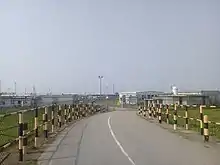Nabiganj Upazila
Nabiganj (Sylheti: ꠘꠛꠤꠉꠂꠘ꠆ꠎ, Bengali: নবীগঞ্জ, romanized: Nobīgonj) is an Upazila of Habiganj District in the Division of Sylhet, Bangladesh.[1]
Nabiganj
ꠘꠛꠤꠉꠂꠘ꠆ꠎ নবীগঞ্জ | |
|---|---|
 | |
| Coordinates: 24°34′N 91°30.9′E | |
| Division | Sylhet Division |
| District | Habiganj District |
| Thana | 1839 |
| Upazila | 1983 |
| Government | |
| • MP (Habiganj-1) | Gazi Mohammad Shahnawaz (Bangladesh Awami League) |
| • Upazila Chairman | Muhammad Fazlul Haq Chowdhury Salim Timirpuri |
| Area | |
| • Total | 439.6 km2 (169.7 sq mi) |
| Population | |
| • Total | 246,933 |
| • Density | 560/km2 (1,500/sq mi) |
| Demonym(s) | Sylhetis |
| Time zone | UTC+6 (BST) |
| Postal code | 3000 |
| Website | nabiganj |
History
After the Conquest of Gour in 1303, many disciples of Shah Jalal migrated and settled in present-day Nabiganj where they preached Islam to the local people. Shah Sikandar migrated to Paschimgaon (Sikandarpur), Hafiz Muhammad Zakariyyah Arabi to Pithua, Shah Sadruddin Qurayshi to Parbatpur (Sadrabad) and Qazi Tajuddin Qurayshi to Chouki.
In the late 17th century, Inathganj Bazar was founded. Inathganj became a centre for the Asian Jute trade. The current Inathganj High School was originally a jute warehouse. Many ships would crowd in the banks of Inathganj Bazar, and go to many corners of the world, and evidence of this remains at the present-day high school.[2]
Geography

Nabiganj is located at 24.56701°N 91.51430°E. It has 41358 households and total area 439.6 km2 (169.7 sq mi).
Demographics
As of the 1991 Bangladesh census, Nabiganj has a population of 246933. Males constitute 50.27% of the population, and females 49.73%. This Upazila's eighteen up population is 126527. Nabiganj has an average literacy rate of 26.4% (7+ years), and the national average of 32.4% literate.[3]
Administration
Nabiganj Upazila is divided into 13 union parishads: Aushkandi, Bausha, Debparra, Digholbak, Gaznaipur, Inatganj, Kaliarbhanga, Kargoan, Kurshi, Nabiganj Sadar, Paniumda, Paschim Bara Bhakoir, and Purba Bara Bhakoir. The union parishads are subdivided into 218 mauzas and 355 villages.[4]
People
- Abdul Moshabbir, lawyer
- Abdur Rouf Choudhury, writer
- Dewan Farid Gazi, politician
- Foysol Choudhury, businessman
- Gazi Mohammad Shahnawaz, politician
- Ismat Ahmed Chowdhury, politician
- Khalilur Rahman Chowdhury, politician
- Shegufta Bakht Chaudhuri, fourth Governor of Bangladesh Bank
- Shah A M S Kibria, former Finance Minister of Bangladesh
- Anudvaipayan Bhattacharya, physician
- Enamul Haque,Deputy Secretary,Bangladesh Parliament secretariat
- Nazrul Hakim,Chief Civil Engineer
Sylhet District
- Dr.Mahbubul Hakim,Assistant Professor of Economics
Sylhet Shahjalal Science &Technology University,Sylhet
References
- Kazi M Hasan Ali (2012). "Nabiganj Upazila". In Islam, Sirajul; Miah, Sajahan; Khanam, Mahfuza; Ahmed, Sabbir (eds.). Banglapedia: the National Encyclopedia of Bangladesh (Online ed.). Dhaka, Bangladesh: Banglapedia Trust, Asiatic Society of Bangladesh. ISBN 984-32-0576-6. OCLC 52727562. Retrieved 23 January 2021.
- Fazlur Rahman (1991). Sileter Mati, Sileter Manush (in Bengali). Sylhet District: M A Sattar.
- "Population Census Wing, BBS". Archived from the original on 2005-03-27. Retrieved November 10, 2006.
- "District Statistics 2011: Habiganj" (PDF). Bangladesh Bureau of Statistics. Archived from the original (PDF) on 13 November 2014. Retrieved 14 July 2014.
